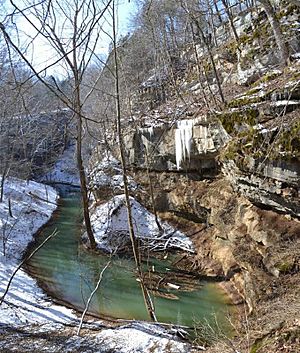Cedar Sink facts for kids
Cedar Sink is a huge, deep hole in the ground, also known as a sinkhole. It's located in Edmonson County, Kentucky, and is part of the famous Mammoth Cave National Park. This sinkhole is about 300 feet (91 meters) deep, from the top of the flat area to its bottom. It formed when the ground above an underground space collapsed.
The area around Cedar Sink has a special type of landscape called karst topography. This means the land is shaped by water dissolving rocks that can melt, like limestone. You'll often find sinkholes, caves, and other depressions called dolines in these areas. Cedar Sink's bottom covers about 7 acres (2.8 hectares) and has rich soil, which is great for plants.
Contents
How Cedar Sink Formed
Rock Ages in Cedar Sink
The rocks you see at Cedar Sink and nearby are very old! They formed during a time called the Mississippian subperiod, which was about 358.9 to 323.2 million years ago. That's even before dinosaurs roamed the Earth!
The Story of Cedar Sink's Creation
Cedar Sink formed when the hard rock layer on top, called the Big Clifty Sandstone caprock, broke open. This exposed softer limestone rocks underneath. The bottom of the sink is about 100 feet (30 meters) deeper, showing even older limestone.
Over a very long time, underground rivers and streams wore away at the rock. This made the ceiling of the underground passages weaker. Eventually, the roof of these passages collapsed, creating the large open sinkhole we see today. Water continues to flow underground, slowly making the sinkhole even wider.
Sinkholes like Cedar Sink are called "collapse sinkholes." They usually start where two underground passages meet, because that's where the roof is widest and weakest. As the underground stream keeps eroding the cave walls, more rock falls, making the passage bigger. Eventually, this big hole reaches the surface.
Sometimes, you can see a stream flowing at the bottom of Cedar Sink, especially after it rains a lot. This visible underground stream makes Cedar Sink a special type of sinkhole called a Karst fenster (or karst window). Most of the water in Cedar Sink comes from two smaller areas called Mill Hole and Procter Cave.
What is Karst Topography?
The Cedar Sink area is a great example of karst topography. This is a landscape created when water dissolves rocks that can melt, such as limestone, dolomite, and gypsum. Karst areas are known for their underground drainage systems, which include sinkholes, dolines, and caves.
Karst forms when rainwater mixes with carbon dioxide from the air, creating a weak acid called carbonic acid. This slightly acidic water seeps into cracks in the bedrock. Over time, these cracks get wider and wider, forming a network of underground channels and caves. The water keeps wearing away at the rocks, and the karst landscape continues to grow and change.
Scientists have studied how water moves through these underground systems for many years. Using tools like GIS, they now have a much better understanding of the complex network of underground rivers and caves in places like Mammoth Cave National Park.
Plants and Animals of Cedar Sink
Cedar Sink has very rich soil and plenty of water. This allows many different kinds of plants to grow there. Some scientists believe that before people settled in the area, there might have been even more dense forests.
Common trees you might find include sugar maple and bitternut hickory. Other trees like tulip trees, chinkapin oaks, and slippery elm also grow here. You might also spot shrubs like pawpaws and spicebush.
On the ground, you can see many different plants. These include Christmas ferns, walking ferns, and various wildflowers like thimbleweed, white snakeroot, and Monarda species. Other plants like Pilea pumila, Polygonum virginianum, and Solidago flexicaulis also thrive here.
Cedar Sink is home to many interesting animals too. One special fish found here is the spring cavefish, which lives in underground springs and caves. You might also see different types of butterflies, such as the question mark butterfly, red-spotted purple, and red admiral. Moths like the tussock moth also live in this area.
Some common flowering plants you can find are cranefly orchids, phlox, tick trefoil, and agrimony. Be careful though, poison ivy also grows here! Other plants include St. John's wort, starry campion, tall bellflower, and Prunella vulgaris. You might even spot a common mushroom called Lactarius growing around Cedar Sink.
Fun Things to Do at Cedar Sink
Hiking the Cedar Sink Trail
If you love to hike, the trail to Cedar Sink is a great adventure! It's about 1.6 miles round trip. The path follows the valley floor for a while and then circles the edge of the sinkhole. You'll find many stairs leading down towards the bottom of the sink, and there are several viewing platforms along the ridge.
The trail offers amazing views of what was once an underground river system. The scenery changes depending on the weather. Sometimes, you'll see small springs flowing strongly, especially after heavy rain. Other times, the overflow routes might be dry. It's a unique chance to see how water shapes the land!
Geocaching at Cedar Sink
Geocaching is like a modern-day treasure hunt, and it's a popular activity at Cedar Sink! People hide small containers called "caches" and then share their GPS coordinates online. You use a GPS device or a smartphone app to find them. There are several geocaches hidden in the Cedar Sink area and throughout Mammoth Cave National Park. It's a fun way to explore and discover new places!


